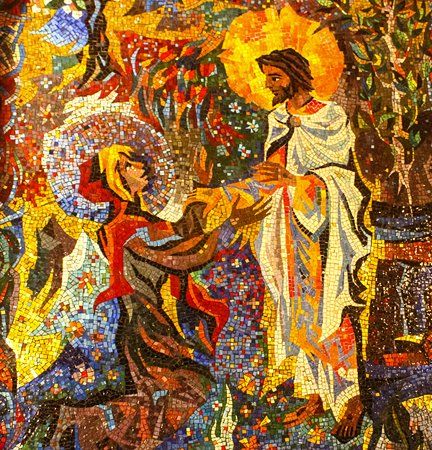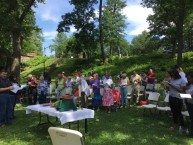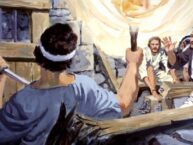 Easter Sunday, April 17, 2022: May God’s words be spoken, may God’s words be heard. Amen.
Easter Sunday, April 17, 2022: May God’s words be spoken, may God’s words be heard. Amen.
Wow!
I know there is no greater story than this: The Lord is Risen!
He is risen indeed!
But my heart is filled with so much joy, because for the first time in two years, the proclamation of the good news is resounding through this church filled with people, not empty pews! Alleluia! Alleluia! Alleluia!
And we should shout out Alleluias, because our return from pandemic is an Easter story! Easter always emerges from the pain of betrayal and denial on Maundy Thursday, the agony of death on Good Friday, and the darkness of the tomb on Holy Saturday. There is no other path to this most joyous light of resurrection – for without Holy Week – the fullness of this joy on Easter is lost. That is why we begin our service today two-thirds of the way in, because this is the last of the three-part Paschal Triduum service.
It is also why this Easter feels so very different for us, because the past two years have seemed like a long time of betrayal, denial, death, and isolation in the darkness of the tomb – and now we emerge to the light and life of resurrection! This is not to say that there won’t be another pandemic, or that we fully out of this one, but we are here in-person for this most holy and sacred time after two long years, and that is very good news for us all. Thanks be to God!
Now, as I note each year, there is very little on which all four of the canonical gospels of Matthew, Mark, Luke, and John agree, except this: Jesus was crucified, Jesus rose from the dead, and the first to bear witness to the resurrection were women. Every – single – time. Mary Magdalene is also the only person named to be at the tomb in all four of the accounts. And in this version from the Gospel of John, the experience of Mary is the one we need to hear most now.
Mary has come in the darkness of the pre-dawn hours to care for the body of Jesus, but found the stone that had been put before the opening of the tomb had been rolled away. After a rather bizarre scene with Peter and another disciple – running past one another, darting in and out of the tomb, and then leaving – Mary remains to mourn for the death of Jesus, and now for her inability to even care for his body – to not even know where he has been taken. She grieves alone in that garden by the tomb.
Many of us have been where Mary is in that moment during this pandemic – unable to be with those we love, even in the hour of their death, even to grieve together at their burial. The loneliness of our isolation, of our heartache, has been overwhelming at times. Of course for Mary, and for each of us today, that is not the end of the story…
She peers through her tears into the tomb again – perhaps with the hope of having missed something. Angels appear in the tomb and ask her why she is weeping – a rather silly question to ask when hanging around a tomb, don’t ya think? After answering she turns, and standing before her is the very one she seeks – Jesus – but she does not recognize him. He too asks her why she is weeping. She tells him, and her grief must have broken through to his heart, so he says to her “Mary.”
I can just imagine that moment, a tenderness for her in this deep despair, can’t you? Anyone who has ever stood beside someone in their grief feels in their heart the compassion of this moment. Jesus came to her in her darkest hour, as she had stood at the foot of the cross in his. Then he calls her by name, she recognizes his voice, and cries out to him. Remember in this gospel Jesus says “my sheep hear my voice.” And through the tears of anguish, his voice speaking her name in love breaks through. She is able to truly see through her tears who is standing before her.
And in her joy at seeing him, she cries “Rabbouni!” – my teacher – something only a disciple in that time would call him. She is his disciple, and if you have been coming here for awhile, then you know that the disciples were not an male only club, even if today some still try to make it so. Not only that, but women financed the ministry, according to the gospel of Luke. So, Mary is a disciple, and now is known as the apostle to the apostles – the one sent to preach to the others the good news of the resurrection. She tells the others “I have seen the Lord!” It is the first proclamation of the gospel.
This is my favorite of all the accounts of the resurrection of Jesus, because it begins in such deep despair – dwelling for a moment in the darkness of Mary’s grief. It doesn’t mask who she was to Jesus either, and Jesus who has not yet ascended, was also not immediately recognizable to this faithful disciple, Mary.
And if all that feels really familiar, you are not alone, because after such a long time in our proverbial pandemic tomb, we are not as we once were, and never will be. Would our 2019 selves even recognize who we are today?
We recognize ourselves in Mary too, because we have wept tears of grief in our years of separation, of disease, of death.
And we know the Jesus in our midst, as we have recognized a voice – deep within – that broke through it all to give us new life to meet each day – that voice of our faith – that voice of Jesus found here and whenever we seek him – the voice of our Christ who meets us where we are, most especially in our darkest night.
The story of these past two years of pandemic is one of death and new life. We grieved the loss of those we loved, of our trust in our nation’s leaders, of the ability to gather with others, of our sense of safety and security to know what is ahead for us. And we wept in despair for it all as we stood at the foot of the cross.
We also rejoiced and gave thanks for good news that rose up from the ashes of our pain – for births of children, for the warmth of the summer when outdoor gatherings could take place, for all those who labored that others may live, and as much as we have grown weary from it, even for the blessing of Zoom.
So, we have been through a time of life and death these past two years, and the faith we proclaim comes with that same paradoxical juxtaposition. It is not just a Christmas and Easter thing, even while there are similarities in both of those events. While the story of Jesus begins with a woman chosen to be the God bearer – Mary the mother of Jesus, and the good news of the resurrection begins with Mary Magdalene, chosen to be the first to proclaim the good news – the Glorias in excelsis deo and Alleluias are only half the story.
The birth of Jesus came with a gift of myrrh for his burial – or as the hymn puts it – he is King, and God, and Sacrifice. And, Easter is never without Good Friday – the empty tomb is rendered meaningless without the cross.
Our faith is one that does not bury the darkness, does not hide from the grief, or pretends that death does not exist. We have no need to pretend that life is a journey from Christmas to Easter – joy to joy, Gloria to Alleluia. No, our faith is rooted in the knowledge that the tears of our darkest nights will always give way to joy in the morning – because we know that Jesus meets us in our deepest grief, and through his compassion, heals our broken hearts by his great love. We know that because Christ lives, death has no dominion over us, light will always overcome darkness, and love wins – every single time.
Our faith is not only a Christmas and Easter story – but an every day walk with the incarnate God – the God who understood the power of being physically present with those we love – and loved us enough to be born for us, to live for us, and to die for us – all that we might know that love deeply and for all time. And having been denied being physically present with one another here for so long, perhaps we have come to appreciate all the more the incarnational reality of the Word made flesh, and of our very human need for being together physically.
Yet we know something else now too, something we always believed, but perhaps had not fully understood until the pandemic hit. Remember back in April of 2020 – in the first weeks of the pandemic shutdown – there were those who said that we closed our churches – but we knew better. We knew that while our buildings were closed – the church – we the body of Christ – we were not. Because if the Easter story teaches us anything it is that nobody, and certainly no pandemic, can put Jesus back in the tomb – he is risen! And no walls or doors can box him in – he is on the loose and so are we!
In his Easter sermon this year, our Presiding Bishop, the Most Rev. Michael Bruce Curry, reminded us of this very thing when he wrote: “In the year 2020, in that first Easter during the pandemic, when our church buildings were closed, we broadcast an Easter service from the National Cathedral, and members of our communication team…. for what may have been the first time in our church’s history, organized an online choir. And they sang an ancient Easter hymn… “The strife is o’er, the battle done. The victory of life is won. The sound of triumph has begun. Alleluia, alleluia.”
Indeed – what Bishop Curry was reminding us is that when we had to close our doors that first Easter, we still sang of the victory of life being won – Alleluia! We sang it then, and today our choir will sing that ancient hymn again as the offertory anthem. And as they sing, we will be reminded that “The powers of death have done their worst, but Christ their legions has dispersed: let shouts of holy joy outburst. Alleluia!”
This is a hymn for our time.
For the powers of death have certainly done their worst, and while the strife of the pandemic is not yet over, and the clouds of war, oppression, poverty, and violence loom over us still – we know that God’s victory over death is real, the song of triumph has begun, and of death’s sting, we, Christ’s servants, are free.
That is the truth we have lived these past two years.
This is the very story of our faith through the centuries.
That is the victory we celebrate – the victory of love over hate, light over darkness, and life over death – then, now, and for all time.
Christ is risen!
He is risen indeed!
Alleluia, alleluia, alleluia!
For the audio, click below, or subscribe to our iTunes Sermon Podcast by clicking here (also available on Audible):
The Rev. Diana L. Wilcox
Christ Church in Bloomfield & Glen Ridge
April 17, 2022
Easter Sunday
1st Reading – Acts 10:34-43
Psalm 118:1-2, 14-24
2nd Reading – 1 Corinthians 15:19-26
Gospel – John 20:1-18





